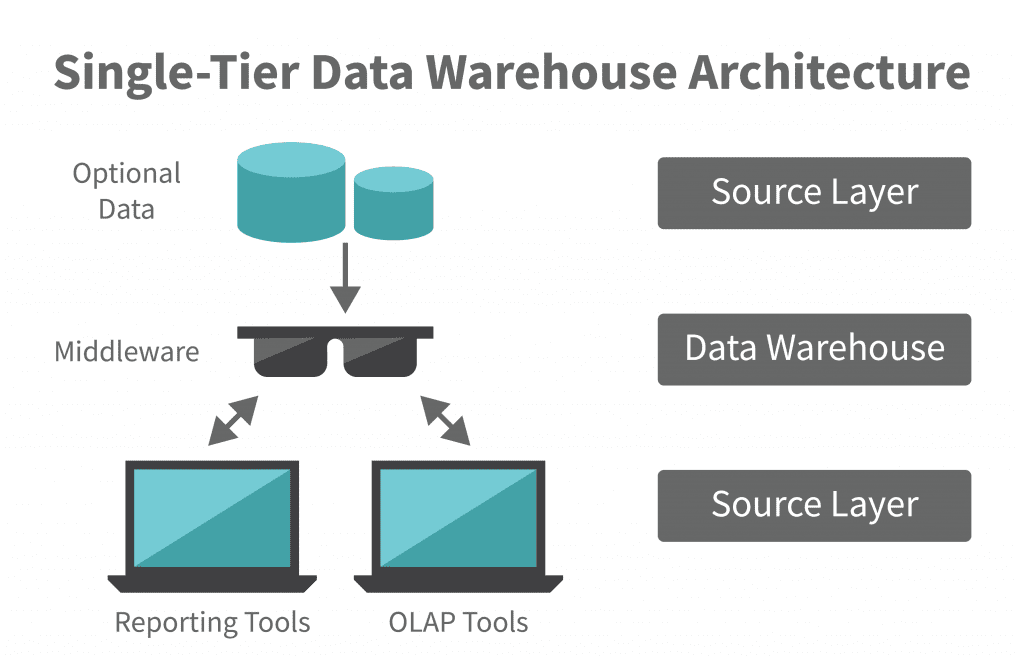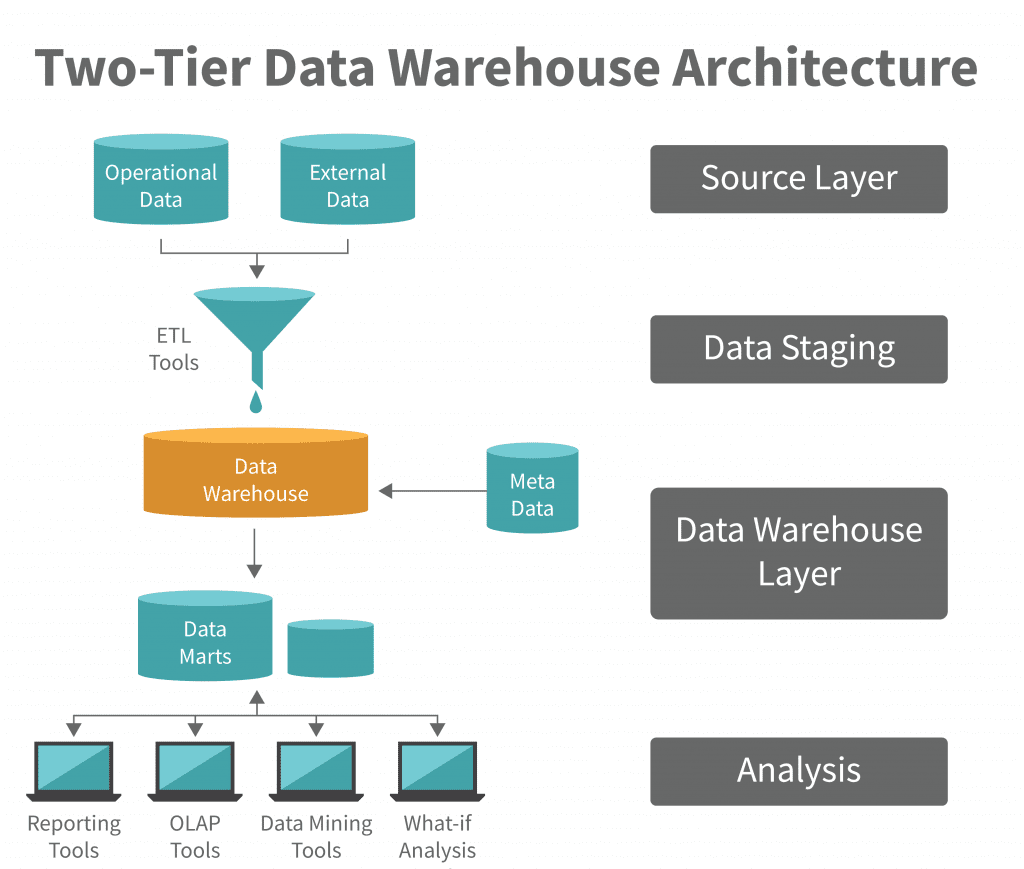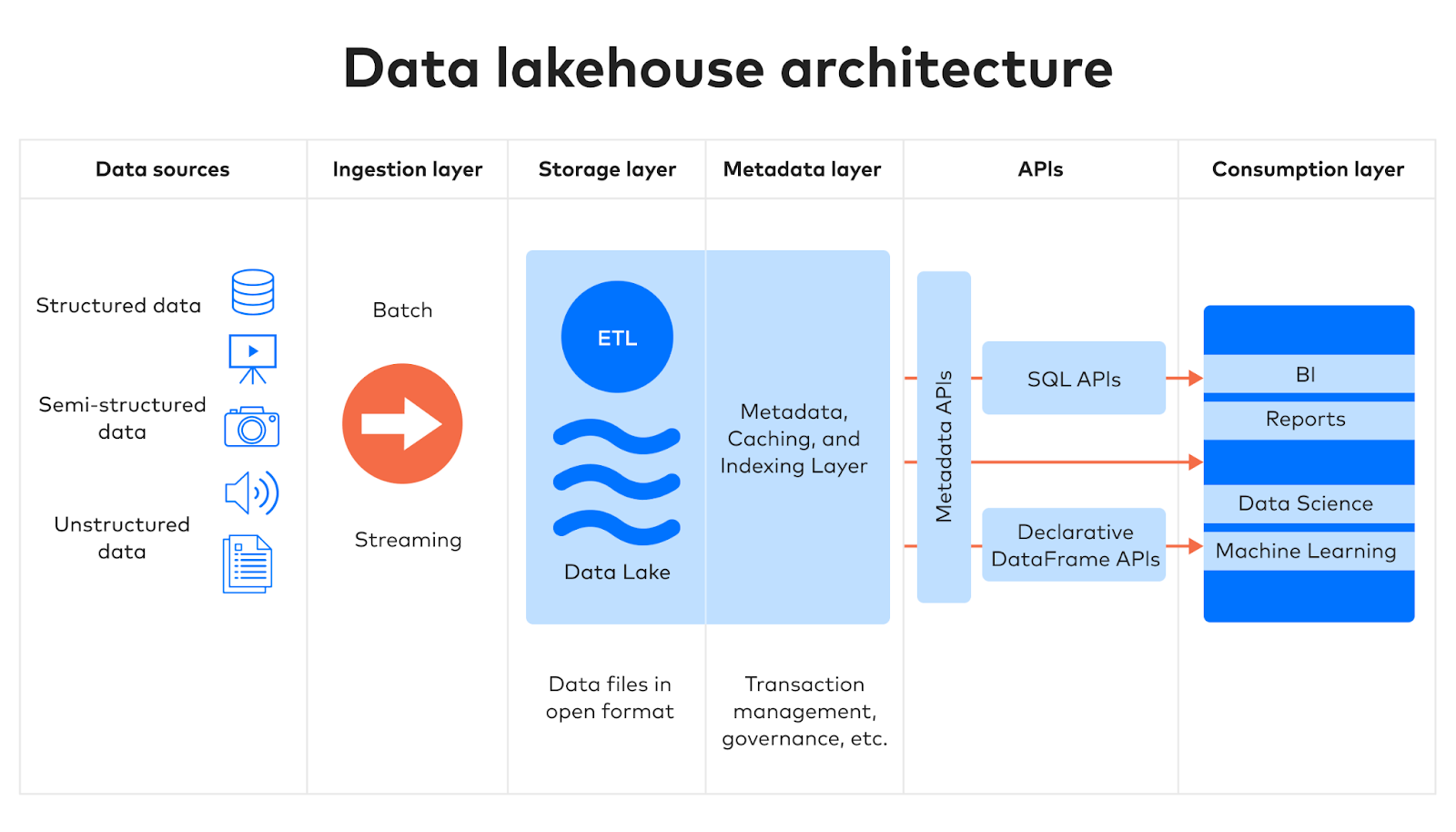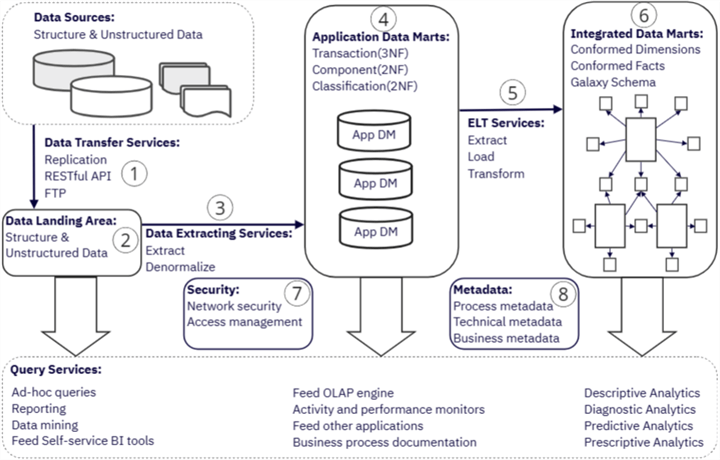Types of Data Warehouse Architecture: Choosing the Right Model
In today’s data-driven landscape, organizations are inundated with vast amounts of information generated from various sources, including customer interactions, transactions, IoT devices, and social media platforms. Effectively managing and analyzing this massive influx of data is crucial for informed decision-making, optimizing business processes, and maintaining a competitive edge. However, raw data in its disparate forms is often unstructured, inconsistent, and challenging to analyze. This is where a well-structured data warehouse architecture becomes indispensable.
A data warehouse architecture is a systematic design that consolidates, organizes, and optimizes data for analysis, ensuring businesses can derive meaningful insights efficiently. By implementing a robust data warehouse architecture, organizations can enhance data governance, improve query performance, and facilitate strategic planning. This article delves into the various types of data warehouse architecture, their advantages, and how to select the most suitable model for your organization’s needs.
What Is Data Warehouse Architecture?
Data warehouse architecture refers to the structured framework that determines how data is collected, stored, and processed within an organization. It enables the integration of multiple data sources, ensuring consistency and accuracy while providing a centralized repository for business intelligence activities. The effectiveness of a data warehouse architecture directly influences an organization’s ability to gain actionable insights and respond to market changes proactively.
Types of Data Warehouse Architecture
Over time, different types of data warehouse architecture have emerged to cater to diverse organizational needs. The primary architectures include:
1. Single-Tier Architecture
A single-tier architecture is the most basic data warehouse architecture, aiming to eliminate data redundancy by consolidating all data into a single layer. It combines both analytical and transactional processes in a unified system.

Image source: Astera
| Advantages | Disadvantages |
|
|
2. Two-Tier Architecture
A two-tier architecture introduces a separation between the operational systems and the data warehouse. Data is extracted from various source systems, transformed, and loaded into the warehouse, where it is processed and made available for analysis.

Image source: Astera
| Advantages | Disadvantages |
|
|
3. Three-Tier Architecture
A three-tier architecture builds upon the two-tier model by introducing an additional layer between the data warehouse and end-user applications.

Image source: Slideteam
Components:
-
Bottom Tier: The database server where data is stored and managed.
-
Middle Tier: The application server that provides an abstraction layer for data processing.
-
Top Tier: The client layer consisting of business intelligence tools and applications for data visualization and reporting.
| Advantages | Disadvantages |
|
|
4. Data Lakehouse Architecture
A data lakehouse architecture is a modern approach that merges the capabilities of data lakes and data warehouses. It allows organizations to store structured and unstructured data while supporting advanced analytics, artificial intelligence, and machine learning applications.

Image source: fivetran
| Advantages | Disadvantages |
|
|
Layers of a Data Warehouse Architecture
A well-structured data warehouse architecture is typically organized into several layers, each serving a distinct function. Understanding the types of data warehouse architecture is crucial for businesses looking to optimize their data processing and analysis. A well-designed data warehouse not only ensures efficient data storage and retrieval but also enables organizations to gain valuable insights from their data, ultimately driving business success.

Image source: Mssqltips
Data Source Layer
The data source layer is the foundation of any types of data warehouse architecture. It comprises various structured and unstructured data sources, including relational databases, flat files, IoT data streams, and external data feeds. Efficient data extraction from these sources is critical, as it sets the stage for accurate analysis and reporting. The ability to integrate diverse data formats effectively determines the success of the overall architecture.
Staging Layer
Once the data is extracted, it moves to the staging layer, where it undergoes processes such as cleansing, transformation, deduplication, and integration. The staging layer ensures data consistency and quality before it enters the storage layer. Businesses that prioritize a strong staging layer within their types of data warehouse architecture can mitigate errors and inconsistencies that may arise from poor data integration.
Data Storage Layer
This layer is the core of any types of data warehouse architecture, serving as a central repository where processed data is stored in an optimized format. The structure of this layer directly impacts query performance and scalability. Organizations must choose between different storage models, such as star schema, snowflake schema, or data vault, based on their analytical needs and data complexity.
Data Presentation Layer
The data presentation layer facilitates data access through business intelligence (BI) dashboards, reporting applications, and query interfaces. A user-friendly data presentation layer is crucial for ensuring that business users can interact seamlessly with data. The best types of data warehouse architecture provide intuitive, real-time access to data, enhancing decision-making efficiency.
Metadata Layer
Metadata is the backbone of a well-structured types of data warehouse architecture. This layer stores critical information about data origins, structures, relationships, and transformations. Organizations leveraging metadata effectively can improve data governance, enhance traceability, and maintain compliance with regulatory requirements.
Five Main Components of a Data Warehouse Architecture
An effective data warehouse architecture is built upon five key components, each playing a crucial role in ensuring data integrity, accessibility, and performance. Understanding these components in-depth provides a clearer perspective on how data flows within an enterprise and supports informed decision-making.
1. Data Warehouse Database
The data warehouse database serves as the central repository, aggregating structured and semi-structured data from various sources. Unlike traditional operational databases that are optimized for transactions, data warehouse databases are designed for analytical processing, enabling complex queries and historical trend analysis. These databases support columnar storage, indexing, and partitioning to optimize query performance. Leading solutions include Amazon Redshift, Google BigQuery, Snowflake, and Microsoft Azure Synapse.
2. Extraction, Transformation, and Loading (ETL) Tools
ETL tools automate the process of gathering, cleansing, and integrating data from multiple sources before loading it into the data warehouse. This process ensures data accuracy, consistency, and readiness for analysis. Modern ETL solutions offer real-time data integration and support event-driven architectures. Cloud-based ETL tools such as AWS Glue and Talend provide scalability and flexibility in handling large datasets efficiently.
3. Metadata Repository
A well-maintained metadata repository acts as the brain of a data warehouse, storing information about data lineage, structure, source origins, and transformation rules. Metadata is categorized into technical metadata (schema definitions, indexes, storage parameters) and business metadata (descriptions of data, business rules, and relationships). This repository improves data governance and enhances discoverability, facilitating efficient data management and compliance with regulations such as GDPR and HIPAA.
4. Query and Reporting Tools
To extract insights from a data warehouse, organizations rely on query and reporting tools that generate visualizations, dashboards, and reports. These tools transform raw data into meaningful analytics, aiding decision-makers in identifying trends and making strategic business moves. Modern solutions such as Tableau, Power BI, and Looker integrate with cloud data warehouses, offering interactive reporting capabilities and AI-driven insights.
5. Data Mining and Analysis Tools
Advanced analytics is a core function of data warehouses, leveraging machine learning, statistical analysis, and predictive modeling to uncover hidden patterns. Data mining tools help detect anomalies, predict customer behavior, and enhance business forecasting. AI-powered analytics platforms, including IBM Watson and Google AI, now integrate directly with data warehouses, automating data discovery and predictive intelligence.
Have a Project Idea in Mind?
Get in touch with Savvycom’s experts for a free consultation. We’ll help you decide on next steps, explain how the development process is organized, and provide you with a free project estimate.
Characteristics of a Good Data Warehouse Architecture
A robust data warehouse architecture should be designed to meet business needs while ensuring optimal performance, security, and scalability. Here are its defining characteristics:
-
Subject-Oriented: Data is structured around key business domains (e.g., sales, finance, marketing) rather than specific applications, making it easier to analyze trends.
-
Integrated: A well-architected data warehouse consolidates data from multiple sources, standardizing formats and ensuring consistency across reports and analyses.
-
Time-Variant: Historical data storage enables organizations to analyze past trends, forecast future performance, and perform longitudinal studies.
-
Non-Volatile: Unlike transactional systems, data in a warehouse remains stable, ensuring reliability for long-term analysis and reducing inconsistencies.
-
Scalable: With businesses generating massive amounts of data, scalability is crucial. Cloud-based architectures provide elastic scaling, accommodating growing data needs.
-
Secure: Data warehouses incorporate role-based access control (RBAC), encryption, and compliance measures to protect sensitive information from cyber threats.
Trends in Data Warehouse Architecture
The evolution of data warehousing is shaped by advancements in technology and the growing need for real-time data processing. Below are the key trends:
1. Cloud-Based Data Warehousing
Organizations are increasingly adopting cloud-based solutions due to their flexibility, lower infrastructure costs, and ease of management. Cloud providers offer managed data warehouse solutions that eliminate the need for on-premise hardware and allow businesses to scale on demand. The global cloud data warehouse market is projected to reach $22.96 billion by 2028, driven by increased enterprise adoption of cloud analytics.

Image source: TBRC
2. Integration of Artificial Intelligence and Machine Learning
AI-driven data warehousing enhances analytical capabilities by enabling real-time insights and automating complex query processing. Machine learning models embedded within data warehouses facilitate anomaly detection, predictive analytics, and automated decision-making.
3. Emphasis on Data Governance and Security
With increasing regulations around data privacy, enterprises prioritize security measures such as encryption, data masking, and identity access management. Robust governance frameworks ensure data integrity and compliance with regulations like GDPR, CCPA, and HIPAA.
4. Real-Time Data Processing
Traditional batch processing is being replaced by real-time data streaming solutions. Technologies like Apache Kafka and AWS Kinesis enable event-driven architectures, allowing organizations to process data as it is generated, improving agility in decision-making.
5. Hybrid Data Warehousing
Hybrid architectures combine on-premise and cloud-based data warehouses, providing a balanced approach to data storage, processing, and cost management. This model benefits organizations with legacy systems that require integration with modern analytics solutions.
Choosing the Right Data Warehouse Architecture
The selection of a data warehouse architecture depends on multiple factors:
-
Data Volume and Variety: Assess whether structured, semi-structured, or unstructured data needs to be stored and processed.
-
Analytical Complexity: Consider whether the warehouse will be used for basic reporting or advanced AI-driven analytics.
-
Scalability Needs: Ensure the architecture can accommodate future data growth without significant performance degradation.
-
Budget Considerations: Evaluate upfront infrastructure costs, licensing fees, and long-term operational expenses.
-
Integration Capabilities: Determine how well the warehouse integrates with existing enterprise applications, data lakes, and third-party tools.
Partnering with a reputable software development company can help organizations design a tailored data warehouse architecture that aligns with their operational and analytical needs.
The Importance of Data Warehousing
A well-implemented data warehouse provides several business advantages:
-
Enhanced Decision-Making: Centralized data repositories offer a single source of truth, reducing inconsistencies and improving business intelligence.
-
Operational Efficiency: Automating data integration and retrieval eliminates manual errors and speeds up analytics workflows.
-
Competitive Edge: Companies leveraging data effectively can identify market trends, optimize resource allocation, and gain an advantage over competitors.
Build a Data Warehouse with the Help of Savvycom
At Savvycom, we recognize the growing importance of data warehousing in today’s digital economy. As a leading software development company, we provide customized data solutions tailored to your business needs.
Why Choose Savvycom for Your Data Warehouse Needs?
-
Expertise in Data Solutions: Our specialists design high-performance data architectures that align with industry best practices.
-
Comprehensive Warehouse Management Systems: We create systems that enhance efficiency, optimize workflows, and improve overall data accessibility.
-
Advanced Inventory Control Tools: Our solutions facilitate real-time tracking, demand forecasting, and inventory optimization.
-
Scalability and Performance: Our architectures are designed to handle increasing data loads while maintaining optimal query performance.
-
Security and Compliance: We implement best-in-class security measures, ensuring your data is protected against unauthorized access.
As businesses continue to generate vast amounts of data, a well-structured data warehouse architecture is more crucial than ever. Savvycom is committed to helping organizations unlock valuable insights, streamline operations, and maintain a competitive edge.
Contact Savvycom today to discover how we can help you build a high-performance data warehouse architecture that meets your business goals!
Tech Consulting, End-to-End Product Development, Cloud & DevOps Service! Since 2009, Savvycom has been harnessing digital technologies for the benefit of businesses, mid and large enterprises, and startups across the variety of industries. We can help you to build high-quality software solutions and products as well as deliver a wide range of related professional services.
Savvycom is right where you need. Contact us now for further consultation:
- Phone: +84 24 3202 9222
- Hotline: +1 408 663 8600 (US); +612 8006 1349 (AUS); +84 32 675 2886 (VN)
- Email: [email protected]


